Adam Yamey's Blog: YAMEY, page 109
October 27, 2022
A gnomon on the esplanade
FOR THOSE WHO DO NOT know, a gnomon is the part of a sundial that casts a shadow.
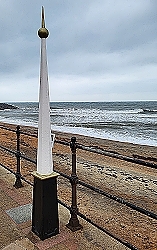 The gnomon on the Esplanade at Ventnor
The gnomon on the Esplanade at VentnorIn 1851, Sir Thomas Brisbane (1773-1860), who gave his name to a city in Australia, donated a tall gnomon to the town of Ventnor on the Isle of Wight. In sunny conditions, this object casts a shadow on a line marked on the pavement at noon GMT (1 pm BST). Sir Thomas had spent some time in Ventnor during the mid-19th century, and sadly his daughter Eleanor Australia MakDougall Brisbane died in Ventnor in 1852 at the young age of 29.
As we are discovering during our visit to the Isle of Wight, the sun does not always shine in Ventnor (or anywhere else on the island). Recognising this problem that renders the gnomon useless when the sun is not shining, the town erected a short clock tower near to the gnomon in 1870. This clock was rebuilt in 2001. It bears a plaque commemorating Fred Blake (1924-2001), who, along with his father (Adolphus) and grandfather (James), were: “… proud to maintain this barometer for over 120 years”.
We did not see the gnomon working because of cloudy weather conditions, and the two faces of the clocks displayed different times and neither of them appeared to be working. The barometer seemed to be working. It is curious features such as the gnomon that help make towns on the English coast endlessly fascinating.
October 26, 2022
Transported back to childhood on the Isle of Wight
IN THE EARLY 1970s, I used to travel on the London Underground’s line from Golders Green to Euston or Warren Street, both stations being near University College London, where I was a student. Back in those days, smoking was permitted on the Underground. Each Northern line tube train had two carriages for smokers. I have never smoked, but I used to travel in the smokers’ carriages because they were usually emptier than the other ones in which smoking was forbidden. Thinking back on this, I suppose that I must have been passively smoking on the Underground. On the other hand, because there were fewer people in the smoking carriages, my chances of catching other people’s airborne germs must have been reduced.
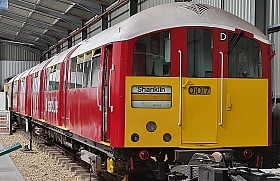
From an early age, before I became a daily commuter, I liked travelling in the rear carriages of the Northern Line tubes. These carriages contained control panels, which the train’s guards operated to open and close the doors and to inform the driver when the train was ready to leave. As a child, I was fascinated by watching the guard at work. Actually, there was little else to watch after the tube entered the tunnel after leaving Golders Green. Incidentally, what was the rear carriage, was also the front carriage when the train changed direction on reaching the end of a line.
The Northern Line trains I have been describing were built by Metro-Cammell in 1938. By the end of the 1980s, the trains were taken out of service and newer units began operating on the Northern Line. The 1938 trains were shipped out to the Isle of Wight, where they carried passengers on the Island Line. After many years of service on the island, the sea air caused these venerable trains to corrode and deteriorate. In the early years of the 21st century, they were taken out of service.
In late October 2022, we visited the train museum at Havenstreet on the Isle of Wight. One of the exhibits is a collection of old train carriages and engines in a large shed. Amongst these exhibits is one of the former Northern Line carriages built in 1938. Visitors are permitted to enter it. I was delighted to find that the example on display was one of the rear carriages containing the guard’s control panels. Seeing these again after so many years was a curiously moving experience. I felt for a moment that I had been transported back to my childhood days, when travelling in these trains used to fill me with wonder.
October 25, 2022
A marriage recorded on stained glass
THE GREAT HALL of Lytes Cary Manor House in Somerset has some stained glass windows decorated with crests relating to the Lyte family, who owned the property between the 15th and 18th centuries. One of the crests caught my eye because the crest contains a double-headed eagle. This is a symbol that began to interest me in my teens when I first became fascinated by the Balkans. The double-headed eagle figures on the flags of Albania and some of its neighbours. The earliest known use of this peculiar creature is on seals used to secure goods in Babylon during the 3rd century BC.
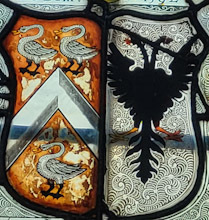
The crest at Lytes Cary Manor is a combination of the Lyte family crest and that of the Worth family, which incorporates the two headed bird.
In 1592, Thomas Lyte (c1568-1638) married Frances Worth (1580-1615) who was born in Charlton Mackrell in Somerset. Thus, the double-headed eagle of the Worth family became joined with the three swans of the Lyte family crest. This marriage which was celebrated so long ago, is recorded in glass on a window of the Great Hall at Lytes Cary.
Why the Worths employed the double-headed eagle on their crest is something I would like to know, and will investigate. The double-headed eagle appears on British crests less frequently than other heraldic creatures. Possibly, andI am only guessing, it relates to the fact that a son of King John, Richard, Duke of Cornwall (1209-1272) was appointed King of The Germans, that was a senior position in the Holy Roman Empire. The symbol of that empire was the double-headed eagle.
A marriage on glass
THE GREAT HALL of Lytes Cary Manor House in Somerset has some stained glass windows decorated with crests relating to the Lyte family, who owned the property between the 15th and 18th centuries. One of the crests caught my eye because the crest contains a double-headed eagle. This is a symbol that began to interest me in my teens when I first became fascinated by the Balkans. The double-headed eagle figures on the flags of Albania and some of its neighbours. The earliest known use of this peculiar creature is on seals used to secure goods in Babylon during the 3rd century BC.

The crest at Lytes Cary Manor is a combination of the Lyte family crest and that of the Worth family, which incorporates the two headed bird.
In 1592, Thomas Lyte (c1568-1638) married Frances Worth (1580-1615) who was born in Charlton Mackrell in Somerset. Thus, the double-headed eagle of the Worth family became joined with the three swans of the Lyte family crest. This marriage which was celebrated so long ago, is recorded in glass on a window of the Great Hall at Lytes Cary.
Why the Worths employed the double-headed eagle on their crest is something I would like to know, and will investigate. The double-headed eagle appears on British crests less frequently than other heraldic creatures. Possibly, andI am only guessing, it relates to the fact that a son of King John, Richard, Duke of Cornwall (1209-1272) was appointed King of The Germans, that was a senior position in the Holy Roman Empire. The symbol of that empire was the double-headed eagle.
October 24, 2022
A polo player in India and Somerset
LYTES CARY is a mediaeval manor in the English county of Somerset. This beautiful building, maintained by the National Trust, was owned by the Lyte family since the 15th century, if not earlier. The Great Hall of the manor house was built in the 1460s. The manor remained in the Lyte family until 1755, when the indebted Thomas Lyte IV surrendered all rights to their family home. Between then and 1907, the property fell into decay.
In 1907, the dilapidated Lytes Cary was purchased by Sir Walter Jenner (1860-1948) and his wife Flora, who died in 1920. They lived with their daughter Esme (1898-1932), a keen horse rider, who died of pneumonia after having been drenched in a rainstorm. Sir Walter was the son of Queen Victoria’s physician, Sir William Jenner (1815-1898), who studied at my alma mater University College in London. At his death, he left a great fortune.
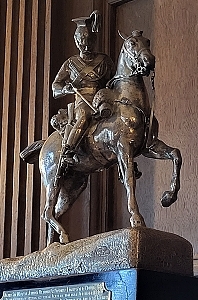 Polo trophy
Polo trophySir Walter had the house repaired and filled it with furniture and objets d’art appropriate to the age of the house. The result was a comfortable home with fascinating contents. One of the many objects that caught my eye is a trophy depicting a military man on a horse. This item bears an engraved plate:
“Major Sir Walter Jenner Bt, from Lt Colonel Forrester Colvin 1915 to commemorate joining the Ninth Lancers together December 1880. The many happy years spent therein and the following polo tournaments won by the regiment…”
Below this, there is a long list of tournaments played in India, England, Wales, and Ireland. In India, he was in the winning teams in Umballa (Ambala) in 1883 and 1884, and in Meerut in 1885. The latest tournament listed on the trophy was in Dublin in 1893.
Educated at Charterhouse School, Sir Walter became a magistrate in Somerset after retiring from the Ninth Lancers. He served in his regiment during WW1 and was awarded the DSO for his services in that conflict.
I enjoy visiting old houses like Lytes Cary and always find it interesting when I discover links between them and the history of India. Sir Walter’s polo trophy is not one of the most attractive pieces on display at Lytes Cary, but for me it was most fascinating.
October 23, 2022
Coloured cliffs and the Needles rocks
NEAR THE WESTERNMOST point on the Isle of Wight, lies Alum Bay. From its pebble beach, the Needles rock formation with their light house can easily be seen. Turn your back on the Needles and you will see that the bay and its beach have a backdrop of folded cliffs. These are not any old cliffs. They are multi-coloured.

The colouration of the cliffs is caused by the presence of oxidised iron compounds formed under different conditions.
The beach from which the coloured cliffs can be seen can be reached two ways. Either by foot, using a series of staircases, or by travelling on a spectacular set of chairs suspended from cables: a sort of funicular. I recommend descending by foot to enjoy the views at leisure and returning using the chair lift. However, descending on the latter is also said to be an exciting experience.
October 22, 2022
A quaint market shelter
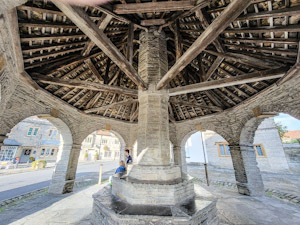 Inside the Buttercross
Inside the ButtercrossTHERE IS AN OLD octagonal building in the market place of Somerton in Somerset. According to a website about the town, this building is:
“… the octagonal shaped market cross; also known as the Buttercross. This was built by the Stawell family in 1673 and given the parish council in 1916 … The market place was a busy and noisy area during market day, and in extremely hot weather the dairy products such as cheese, butter and milk would soon go off. These goods would also be ruined in wet weather, and so a shelter was required that would shade and cover the products from the weather conditions. The Buttercross was the ideal solution, as it was both cool and dry. It is now listed as a Grade II ancient monument, and has been repaired on a couple of occasions during the last century.” (from: http://www.somerton.co.uk/virtual-tour/market-cross/)
It is not the only octagonal structure in Somerton. The tower of the mediaeval parish church is also octagonal.
October 21, 2022
More than meets the eye on the moor
FROM OUTSIDE IT looked like a ‘bog standard’ pub on Dartmoor. The kind of pub in which you would expect to find weary walkers and cyclists, all dressed in appropriate outdoor gear splattered with mud. The sort of place where the customers wear walking boots and thick woolly socks that reach halfway up their calves. An old-fashioned country pub with a roaring open fire. You know the kind of place, quaintly decorated with folks objects such as horse brasses, copper bed pans, Toby jugs and so on. A pub where you would find sandwiches and chips as the only solid fare. However, despite looking like the kind of hostelry just described, The Dartmoor Inn Merrivale is quite a different ‘kettle of fish’.
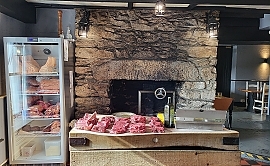
On stepping through its entrance door, the first thing you will notice is a large wooden butcher’s slap piled with raw steaks of various kinds and cuts: sirloin, rumps, chateaubriand, rib eyes, huge tomahawks, and other tasty chunks of meat. Behind this in what was formerly a fire place, there is a sophisticated charcoal grill for cooking these meaty offerings. A chef coats the meat with sprinkling of salt, oil, and herbs before grilling it.
The pub’s decor is far from traditional. It is simply decorated in a contemporary style with a few good artworks on the walls. The pub is owned by a local organic farm, which also has shops in Marlborough, Totnes, Tavistock, and London (in Selfridges Food Hall).
For our midday meal, we ordered a Ploughman’s Lunch contains amongst other things excellent cheddar and locally made ham, and a plate of superb barely cooked roast beef. The food could not be faulted. The staff were enthusiastic about food and were very attentive.
The Dartmoor Inn has reasonably priced rooms for overnight stays. We hope to return, spend the night, and sample the excellent looking steaks on offer.
Just as it is unfair to judge a book by its cover, one should not rate a pub by its external appearance.
October 20, 2022
A numerical oddity in Cornwall
TRERICE HOUSE IN Cornwall was built mainly between 1570 and 1573. It is one of the loveliest National Trust (‘NT’) properties in the county and one of my top ten. In one of the upper rooms there is an ornate bas-relief above the fireplace. The top of this bears the following:
“ANNO: DOMINI: M : CCCCC : LXX3”
It is clearly a date in mostly Roman numerals, (i.e., 1573). However, this date has several odd features.

‘CCCCC’ is 500, but usually abbreviated to ‘D’ in Roman numerals. There is a surplus of colons (‘:’) and instead of ending in a Roman numeral, there is the Arabic numeral ‘3’. Or is it the symbol for a serpent, rather than a ‘3’? It is a curiously shaped 3: it is widest at the top and tapers towards its lower end.
The NT volunteer offering information in the room with this curious date suggested three possible explanations for this peculiar form of the date above the fireplace. One is that the creator of this date miscalculated the amount of space, and instead of ending the date in ‘: III’, used the Arabic ‘3’ to fit in the last part of the date. Had he used ‘D’ instead of the unusual ‘CCCCC’, there would have been plenty of space to fit in the entire date using only Roman numerals. Another explanation offered is that the ‘3’ is really a stylised serpent, a symbol of wisdom often associated with Queen Elizabeth I, during whose reign the house was built.
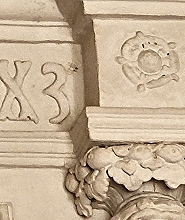 3 or a serpent?
3 or a serpent?The last explanation was provided by a builder, who had visited Trerice some weeks before us. He suggested that the ‘3’ was added to indicate that the building works were supposed to have been completed in 1570, but had finished 3 years later than expected; the builders were running behind schedule.
Whatever the explanation of the curiously written date, and you might have another theory, Trerice is well worth a visit.
October 19, 2022
Missing on a flight over the Atlantic
ST COULOMB MAJOR is a small town in north central Cornwall. It has a beautiful gothic parish church, St Columba, which dates to the 13th to 15th centuries. Inside, on the north wall of the church, there is a memorial plaque that caught my eye and roused my curiosity. It lists 18 people, members of the Royal Air Force (‘RAF’) along with their ranks. The plaque was place in memory of:
“Members of two crews of No. 42 Squadron Royal Air Force missing on a flight over the Atlantic. January 11th 1955.”
I was both horrified and intrigued by this.
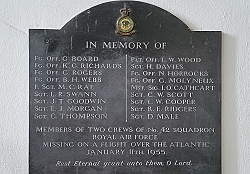
Both ‘planes that were lost were Shackletons. At 10.14 am, Shackleton WG531 took off from RAF St Eval to commence a routine 15-hour patrol over a part of the Atlantic. At 10.20, Shackleton WL743 took off from the same airfield to join WG 531 on patrol in the same area. At 20.00, the two planes were 85 miles apart. At 20.58, a ground-based radio operator tried to make contact with WL 743, but was unable to do so. This was not cause for alarm because contact was often difficult when planes were at normal operating altitude.
After both aircraft failed to return at the expected time, a search and rescue operation was launched. An extensive search failed to discover either of the aircraft or any bodies of the crew members. In July 1966, one of the engines of WL 743 was caught up in a trawler’s net. Despite a thorough board of inquiry, no plausible explanation of the planes’ disappearances was provided.
St Coulomb Major is 4 miles southeast of RAF St Eval (as the crow flies). There is a church, St Mawgan, between these two places, but that in St Columb Major is larger. Maybe, that is why the memorial to the airmen is where it is. Apart from the RAF plaque, the church contains many other items of interest including its font (c. 1300), which has several faces carved on it.



